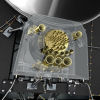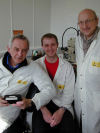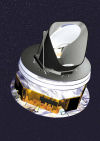The "coolest" spacecraft in the Universe
The University of Manchester's Jodrell Bank Observatory involvement in the ESA Planck mission
22nd February 2007
The European Space Agency's (ESA) Planck mission, which will study the conditions present in our Universe shortly after the Big Bang, is reaching an important milestone with the integration of instruments into the satellite at Alcatel Alenia Space in Cannes, France. University of Manchester scientists and engineers at Jodrell Bank Observatory have contributed some of the key receivers that are now being incorporated into the spacecraft.
Planck will observe radiation from the dawn of time to investigate with the highest precision ever the cosmic microwave background (CMB) - the remnants of the radiation that filled the Universe immediately after the Big Bang some 14 billion years ago. Planck will be sensitive to temperature variations of a few millionths of a degree and will map the full sky in nine wavelengths. The tiny differences in the CMB are like the marks in a fossil, revealing details about the organism they come from - in this case, the physical processes at the beginning of the Universe.
Planck carries a 1.5 metre diameter telescope that feeds the microwave radiation to two instruments which will image the sky at different frequencies:- the Low Frequency Instrument (LFI) consisting of an array of ultra sensitive radiometers and the High Frequency Instrument (HFI), an array of highly sensitive microwave detectors known as bolometers.

A "tranparent" model of the horn and reciever systems of the Planck spacecraft. The Jodrell Bank built recievers lie behind the larger horns of the Low Frequency Instrument (LFI). (Copyright: ESA/AOES Medialab)
Jodrell Bank staff are proud to have played an important role in the design and fabrication of the 30 and 44 GHz front end modules (FEM,s) for the Planck Low Frequency Instrument. The work was funded by the UK's Particle Physics and Astronomy Research Council (PPARC).The specified performance targets, though very challenging, were met and Jodrell Bank has produced the most sensitive receivers ever built at these frequencies. JBO scientists will be also be deeply involved in the mission after its launch in 2008 and the subsequent science that will flow from the observations.

Richard Davis, Edward Blackhurst and Frank Winder have been involved with the design and construction of Low Frequency Recievers for the Planck Spacecraft.(Copyright:JBO)
The mission will address a number of fundamental questions, such as the initial conditions for the evolution of our Universe's structure, the nature and amount of dark matter and the nature of dark energy and the expansion of the Universe itself. The instruments on board Planck will allow scientists to measure the temperature variations across the cosmic microwave background with much better sensitivity than ever before providing astronomers with an unprecedented view of our Universe when it was extremely young - just 300,000 years old.
After integration which is due to be completed by the end of February, Planck will move to Liege in Belgium to undergo a series of tests to measure the performance of the instruments at extreme temperatures. The Launch of the Planck spacecraft is scheduled for July 31st, 2008.
Contacts at Jodrell Bank Observatory
Dr Richard Davis - Tel: 01477 571321. Email: rjd@jb.man.ac.uk
Dr Althea Wilkinson - Tel: 01477 571321. Email: aw@jb.man.ac.uk
Notes to Editor
JBO involvement
Jodrell Bank, University of Manchester were awarded a 2 Million PPARC grant to design and develop and build the 30 and 44 GHz front end modules (FEM,s) for the Low frequency instrument (LFI) for the Planck spacecraft. The specification of 8K noise temperature for 30 GHz and 14K for 44 GHz was very challenging. The FEM,s achieved this and are the lowest noise temperatures measured at these frequencies. We are now deeply involved in the mission after launch and subsequent science.
Website
ESA Planck overview - http://www.esa.int/esaSC/120398_index_0_m.html
Science Objectives of Planck
Planck's maps will allow a number of specific investigations to take place:
- The determination of the Universe's fundamental characteristics such as the overall geometry of space, the density of normal matter and the rate at which the Universe is expanding.
- A test of whether the Universe passed through a period of rapidly accelerated expansion just after the Big Bang. This period is known as inflation.
- The search for "defects" in space, for example cosmic strings, that could indicate that the Universe fundamentally changed state early in its existence.
- Accurate measurement of the variations in the microwave background that grew into the largest structures today: filaments of galaxies and voids.
- A survey of the distorting effects of modern galaxy clusters on the microwave cosmic background radiation, giving the internal conditions of the gas in the galaxy clusters.
The Planck spacecraft was built by AAS Cannes, the prime contractor, leading a consortium of industrial partners with the AAS industry branch in Turin, Italy, responsible for the satellite's service module. ESA and the Danish Space Centre are responsible for the hardware provision of Planck's telescope mirrors, manufactured by EADS Astrium (Friedrichshafen, Germany).
AAS Cannes is also responsible for the payload module, the platform that hosts the telescope and the two onboard instruments, HFI and LFI. The instruments themselves are being supplied by a consortium of scientists and institutes led by the Institute d'Astrophysique Spatiale at Orsay (France) and in the case of HFI, and by the Instituto di Astrofiscia Spaziale e Fisica Cosmica (IASF) in Bologna (Italy) in the case of LFI).
The Particle Physics and Astronomy Research Council (PPARC) is the UK's strategic science investment agency. It funds research, education and public understanding in four areas of science - particle physics, astronomy, cosmology and space science.
PPARC is government funded and provides research grants and studentships to scientists in British universities, gives researchers access to world-class facilities and funds the UK membership of international bodies such as the European Laboratory for Particle Physics (CERN), and the European Space Agency. It also contributes money for the UK telescopes overseas on La Palma, Hawaii, Australia and in Chile, the UK Astronomy Technology Centre at the Royal Observatory, Edinburgh and the MERLIN/VLBI National Facility, which includes the Lovell Telescope at Jodrell Bank Observatory.
PPARC is a partner in the British National Space Centre [BNSC] which coordinates the UK's civil space activities.



